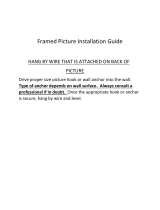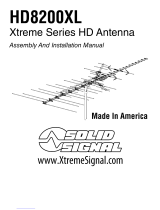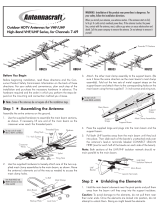TERK Technologies TV36 User manual
- Category
- Television antennas
- Type
- User manual
This manual is also suitable for
TERK Technologies TV36 is a medium directional UHF/VHF/FM antenna designed to enhance your home entertainment experience.
With its 33 active elements, this antenna can pick up signals from all directions, providing you with crystal-clear reception of your favorite TV shows, movies, and music. The TV36 is also equipped with an antenna selector, allowing you to choose between UHF, VHF, or FM bands for optimal signal reception.
Its compact size and lightweight design make it easy to install on your roof or chimney, and its sturdy construction ensures durability in all weather conditions.
TERK Technologies TV36 is a medium directional UHF/VHF/FM antenna designed to enhance your home entertainment experience.
With its 33 active elements, this antenna can pick up signals from all directions, providing you with crystal-clear reception of your favorite TV shows, movies, and music. The TV36 is also equipped with an antenna selector, allowing you to choose between UHF, VHF, or FM bands for optimal signal reception.
Its compact size and lightweight design make it easy to install on your roof or chimney, and its sturdy construction ensures durability in all weather conditions.








-
 1
1
-
 2
2
-
 3
3
-
 4
4
-
 5
5
-
 6
6
-
 7
7
-
 8
8
TERK Technologies TV36 User manual
- Category
- Television antennas
- Type
- User manual
- This manual is also suitable for
TERK Technologies TV36 is a medium directional UHF/VHF/FM antenna designed to enhance your home entertainment experience.
With its 33 active elements, this antenna can pick up signals from all directions, providing you with crystal-clear reception of your favorite TV shows, movies, and music. The TV36 is also equipped with an antenna selector, allowing you to choose between UHF, VHF, or FM bands for optimal signal reception.
Its compact size and lightweight design make it easy to install on your roof or chimney, and its sturdy construction ensures durability in all weather conditions.
Ask a question and I''ll find the answer in the document
Finding information in a document is now easier with AI
Related papers
-
TERK Technologies VS-4 User manual
-
TERK Technologies AM/FM Tower Powered Indoor Antenna User manual
-
TERK Technologies AM/FM Tower Powered Indoor Antenna Owner's manual
-
TERK Technologies Terk FM+ Owner's manual
-
Terk Tower User manual
-
TERK Technologies TV38 HDTV User manual
-
TERK Technologies TV38 HDTV User manual
-
TERK Technologies PI2ZV User manual
-
TERK Technologies OMNITVEX User manual
-
Terk Edge User manual
Other documents
-
 Melissa Van Hise HDLC28126 Installation guide
Melissa Van Hise HDLC28126 Installation guide
-
Shakespeare Electronic 476 User manual
-
Audiovox BDSP1 Warranty
-
 Solid Signal Xtreme HD8200XL Assembly And Installation Manual
Solid Signal Xtreme HD8200XL Assembly And Installation Manual
-
Winegard HD-1080 User manual
-
Audiovox BDSP1 Warranty
-
 AntennaCraft HBU22 Assembly Manual
AntennaCraft HBU22 Assembly Manual
-
Voyager JAN139 User manual
-
Winegard PR-8800 User manual
-
Winegard PR-8800 User manual










